Assessing the Impacts of Dike Systems on Water Quality in Natural Reserves of the Vietnamese Mekong Delta
Abstract
:1. Introduction
2. Materials and Methods
2.1. Materials
2.1.1. Apparatus and Chemicals
2.1.2. Study Area
2.2. Methodology
2.2.1. Water Sampling
2.2.2. Data Collection
2.3. Data Analysis
2.3.1. Descriptive Statistics Method
2.3.2. Water Quality Assessment
3. Results and Discussions
3.1. Hydrological Regime in LNHNR
3.2. Weighted Arithmetic Water Quality Index
4. Conclusions
Author Contributions
Funding
Institutional Review Board Statement
Informed Consent Statement
Data Availability Statement
Acknowledgments
Conflicts of Interest
References
- Dat, T.Q.; Kanchit, L.; Thares, S.; Trung, N.H. Modeling the Influence of River Discharge and Sea Level Rise on Salinity Intrusion in Mekong Delta. In Proceedings of the 1st EnvironmentAsia International Conference, Bangkok, Thailand, 22–25 March 2011; Volume 35, pp. 685–701. [Google Scholar]
- Thu Minh, H.V.; Avtar, R.; Kumar, P.; Le, K.N.; Kurasaki, M.; Ty, T.V. Impact of Rice Intensification and Urbanization on Surface Water Quality in An Giang Using a Statistical Approach. Water 2020, 12, 1710. [Google Scholar] [CrossRef]
- Minh, H.V.T.; Kurasaki, M.; Ty, T.V.; Tran, D.Q.; Le, K.N.; Avtar, R.; Rahman, M.M.; Osaki, M. Effects of Multi-Dike Protection Systems on Surface Water Quality in the Vietnamese Mekong Delta. Water 2019, 11, 1010. [Google Scholar] [CrossRef] [Green Version]
- Nhan, H.T.T.; Tinh, T.K.; Hung, P.V. Managerial Status of Protected Areas in Viet Nam. Available online: https://repository.vnu.edu.vn/handle/VNU_123/10033 (accessed on 15 October 2021).
- Trang, N.T.N.; Dan, T.H. Assessment of the Farming Models in the Lung Ngoc Hoang Nature Reserve in Hau Giang Province. Available online: http://www.iebr.ac.vn/PAGES/proceedings7_Display.asp (accessed on 22 October 2021).
- Brown, R.M.; McClelland, N.I.; Deininger, R.A.; Tozer, R.G. A Water Quality Index-Do We Dare. Water Sew. Work. 1970, 117, 339–343. [Google Scholar]
- Tyagi, S.; Sharma, B.; Singh, P.; Dobhal, R. Water Quality Assessment in Terms of Water Quality Index. AJWR 2013, 1, 34–38. [Google Scholar] [CrossRef]
- Dunnette, D. A Geographically Variable Water Quality Index Used in Oregon. J. Water Pollut. Control. Fed. 1979, 51, 53–61. [Google Scholar]
- Dinius, S.H. Design of an index of water quality. J. Am. Water Resour. Assoc. 1987, 23, 833–843. [Google Scholar] [CrossRef]
- Kumar, D.; Alappat, B.J. NSF-Water Quality Index: Does It Represent the Experts’ Opinion? Pract. Period. Hazard. Toxic Radioact. Waste Manag. 2009, 13, 75–79. [Google Scholar] [CrossRef]
- Khan, A.A.; Paterson, R.; Khan, H. Modification and Application of the Canadian Council of Ministers of the Environment Water Quality Index (CCME WQI) for the Communication of Drinking Water Quality Data in Newfoundland and Labrador. Water Qual. Res. J. 2004, 39, 285–293. [Google Scholar] [CrossRef] [Green Version]
- Khan, A.A.; Tobin, A.; Paterson, R.; Khan, H.; Warren, R. Application of CCME Procedures for Deriving Site-Specific Water Quality Guidelines for the CCME Water Quality Index. Water Qual. Res. J. 2005, 40, 448–456. [Google Scholar] [CrossRef]
- Akter, T.; Jhohura, F.T.; Akter, F.; Chowdhury, T.R.; Mistry, S.K.; Dey, D.; Barua, M.K.; Islam, M.A.; Rahman, M. Water Quality Index for Measuring Drinking Water Quality in Rural Bangladesh: A Cross-Sectional Study. J. Health Popul. Nutr. 2016, 35, 1–12. [Google Scholar] [CrossRef] [Green Version]
- Amadi, A.; Olasehinde, P.; Okosun, E.; Yisa, J. Assessment of the Water Quality Index of Otamiri and Oramiriukwa Rivers. Phys. Int. 2010, 1, 102–109. [Google Scholar]
- Yisa, J.; Tijani, J.O. Analytical Studies on Water Quality Index of River Landzu. Am. J. Appl. Sci. 2010, 7, 453–458. [Google Scholar] [CrossRef] [Green Version]
- EZODO Instrument. Ezodo 7031 Waterproof Multi-Function Pocket Meter User Manual. 2016. Available online: https://www.manualslib.com/manual/1480487/Ezodo-Pl-700al.html#manual (accessed on 10 March 2021).
- Adwa Instrument. Manual Adwa AD12 Waterproof pH Testers. 1998. Available online: https://adwainstruments.com/manuals/manual_ad11_12.pdf (accessed on 17 October 2021).
- HM Instrument. Manual HM-COM 100 Waterproof Professional Series EC/TDS Meter. 2000. Available online: http://hmdigital.com/wp-content/uploads/2016/11/com100manual.pdf (accessed on 17 October 2021).
- GOnDO Instrument. Manual Tub-430 Portable Microprocessor Turbidity Meter. 2016. Available online: https://www.manualsdir.com/manuals/311336/xylem-turb-430-portable-turbidity-meter.html?original=1 (accessed on 17 October 2021).
- Vietnam Environment Administration. National standard TCVN 6663-3:2016 (ISO 5667-3:2012) on Water Quality—Sampling—Part 3: Preservation and Handing of Water Samples. 2016. Available online: https://vanbanphapluat.co/tcvn-6663-3-2016-iso-5667-3-2012-chat-luong-nuoc-lay-mau-phan-3#van-ban-goc (accessed on 7 February 2021).
- Sarwar, S.; Ahmmed, I.; Mustari, S.; Shaibur, M.R. Use of Weighted Arithmetic Water Quality Index (WAWQI) to Determine the Suitability of Groundwater of Chaugachcha and Manirampur Upazila, Jashore, Bangladesh. Environ. Biolog. Res. 2020, 2, 22–30. [Google Scholar]
- Chandra, D.S.; Asadi, S.; Raju, M.V.S. Estimation of water quality index by weighted arithmetic water quality index method: A model study. Int. J. Civ. Eng. Technol. 2017, 8, 1215–1222. [Google Scholar]
- Sârbu, C.; Pop, H. Principal Component Analysis versus Fuzzy Principal Component Analysis: A Case Study: The Quality of Danube Water (1985–1996). Talanta 2005, 65, 1215–1220. [Google Scholar] [CrossRef]
- Akoteyon, I.; Omotayo, A.; Soladoye, O.; Olaoye, H. Determination of Water Quality Index and Suitability of Urban River for Municipal Water Supply in Lagos-Nigeria. Eur. J. Sci. Res. 2011, 54, 263–271. [Google Scholar]
- Yogendra, K.; Puttaiah, E. Determination of Water Quality Index and Suitability of an Urban Waterbody in Shimoga Town, Karnataka. In Proceedings of the Taal 2007: The 12th World Lake Conference, Jaipur City, India, 29 October–2 November 2007; pp. 342–346. [Google Scholar]
- Miller, W.; Joung, H.; Mahannah, C.; Garrett, J. Identification of Water Quality Differences in Nevada through Index Application. J. Environ. Quality 1986, 15, 265–272. [Google Scholar] [CrossRef]
- Chowdhury, R.M.; Muntasir, S.Y.; Hossain, M.M. Water Quality Index of Water Bodies along Faridpur-Barisal Road in Bangladesh. Glob. Eng. Tech. Rev. 2012, 2, 1–8. [Google Scholar]
- Paun, I.; Cruceru, L.; Chiriac, F.L.; Niculescu, M.; Vasile, G.; Marin, N.M. Water Quality Indices-Methods for Evaluating the Quality of Drinking Water. INCD ECOIND—International Symposium-SIMI 2016. The Environment and the Industry. Proceeding Book. Available online: https://www.researchgate.net/publication/309304038_WATER_QUALITY_INDICES_-_METHODS_FOR_EVALUATING_THE_QUALITY_OF_DRINKING_WATER (accessed on 17 October 2021).
- Brown, R.M.; McClelland, N.I.; Deininger, R.A.; O’Connor, M.F. A Water Quality Index—Crashing the Psychological Barrier. In Indicators of Environmental Quality; Springer: Berlin/Heidelberg, Germany, 1972; pp. 173–182. [Google Scholar]
- Ministry of Natural Resources and Environment (Vietnam). QCVN 08-MT: 2015/BTNMT National Technical Regulation on Surface Water Quality. Available online: http://vea.gov.vn/Quy%20chun%20Vit%20Nam/QCVN%2008-MT-2015-BTNMT.pdf (accessed on 23 October 2021).
- Indian Council of Medical Research. Manual of Standards of Quality for Drinking Water Supplies. 1975, Spe. Rep. Ser. No. 44: p. 27. Available online: http://www.sciepub.com/reference/34835 (accessed on 13 May 2021).
- Etim, E.; Odoh, R.; Itodo, A.; Umoh, S.; Lawal, U. Water Quality Index for the Assessment of Water Quality from Different Sources in the Niger Delta Region of Nigeria. Front. Sci. 2013, 3, 89–95. [Google Scholar]
- Jyothi, S.; Thomas, G.M.; RV, R.R.; Masetti, A.; Tammana, A.; Motheram, M.; Gutlapalli, N.C. Assessment of Water Quality Index and Study of the Impact of Pollution on the Rivers of Kerala. Mater. Today Proc. 2021, 43, 3447–3451. [Google Scholar]
- Tam, N.T.; Bao, T.Q.; Minh, H.V.T.; Thanh, N.T.; Lien, B.T.B.; Minh, D.T.T. Assessment of Surface Water Quality due to the impact of activities in Can Tho City. Vietnam J. Hydrometeorol. 2022, 733, 39–55. [Google Scholar] [CrossRef]
- Minh, H.V.T.; Tam, N.T.; Nhu, D.T.H.; Thanh, N.T.; Ty, T.V. Assessment of the Surface Water Quality and Effectiveness of Triple-Glutinous Rice Cropping System in the Full–Dike Protected Area of Bac Vam Nao, An Giang. Vietnam J. Hydrometeorol. 2021, 732, 38–48. [Google Scholar] [CrossRef]
- Thu Minh, H.V.; Tri, V.P.; Ut, V.N.; Avtar, R.; Kumar, P.; Dang, T.T.; Hoa, A.V.; Ty, T.V.; Downes, N.K. A Model-Based Approach for Improving Surface Water Quality Management in Aquaculture Using MIKE 11: A Case of the Long Xuyen Quadangle, Mekong Delta, Vietnam. Water 2022, 14, 412. [Google Scholar] [CrossRef]
- Mutea, F.G.; Nelson, H.K.; Au, H.V.; Huynh, T.G.; Vu, U.N. Assessment of Water Quality for Aquaculture in Hau River, Mekong Delta, Vietnam Using Multivariate Statistical Analysis. Water 2021, 13, 3307. [Google Scholar] [CrossRef]
- Yang, Y.; Zhang, H.; Zhao, X.; Chen, Z.; Wang, A.; Zhao, E.; Cao, H. Effects of Urbanization on Ecosystem Services in the Shandong Peninsula Urban Agglomeration, in China: The Case of Weifang City. Urban Sci. 2021, 5, 54. [Google Scholar] [CrossRef]
- Avtar, R.; Komolafe, A.A.; Kouser, A.; Singh, D.; Yunus, A.P.; Dou, J.; Kumar, P.; Gupta, R.D.; Johnson, B.A.; Thu Minh, H.V.; et al. Assessing Sustainable Development Prospects through Remote Sensing: A Review. Remote Sens. Appl. Soc. Environ. 2020, 20, 100402. [Google Scholar] [CrossRef]
- Chakraborty, S.; Avtar, R.; Raj, R.; Thu Minh, H.V. Village Level Provisioning Ecosystem Services and Their Values to Local Communities in the Peri-Urban Areas of Manila, The Philippines. Land 2019, 8, 177. [Google Scholar] [CrossRef] [Green Version]
- Wang, Y.; Gao, J.; Wang, J.; Qiu, J. Value Assessment of Ecosystem Services in Nature Reserves in Ningxia, China: A Response to Ecological Restoration. PLoS ONE 2014, 9, e89174. [Google Scholar] [CrossRef]
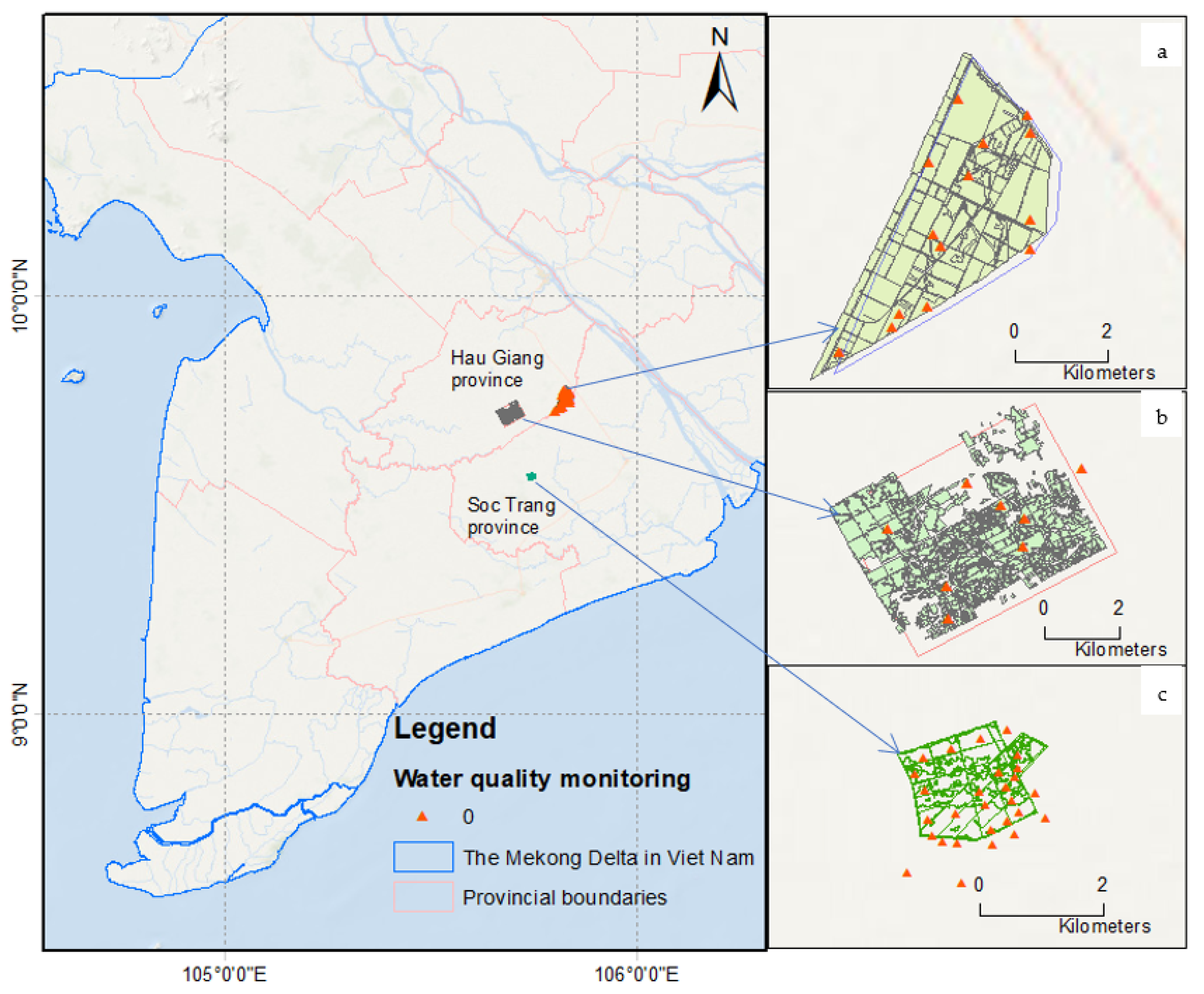
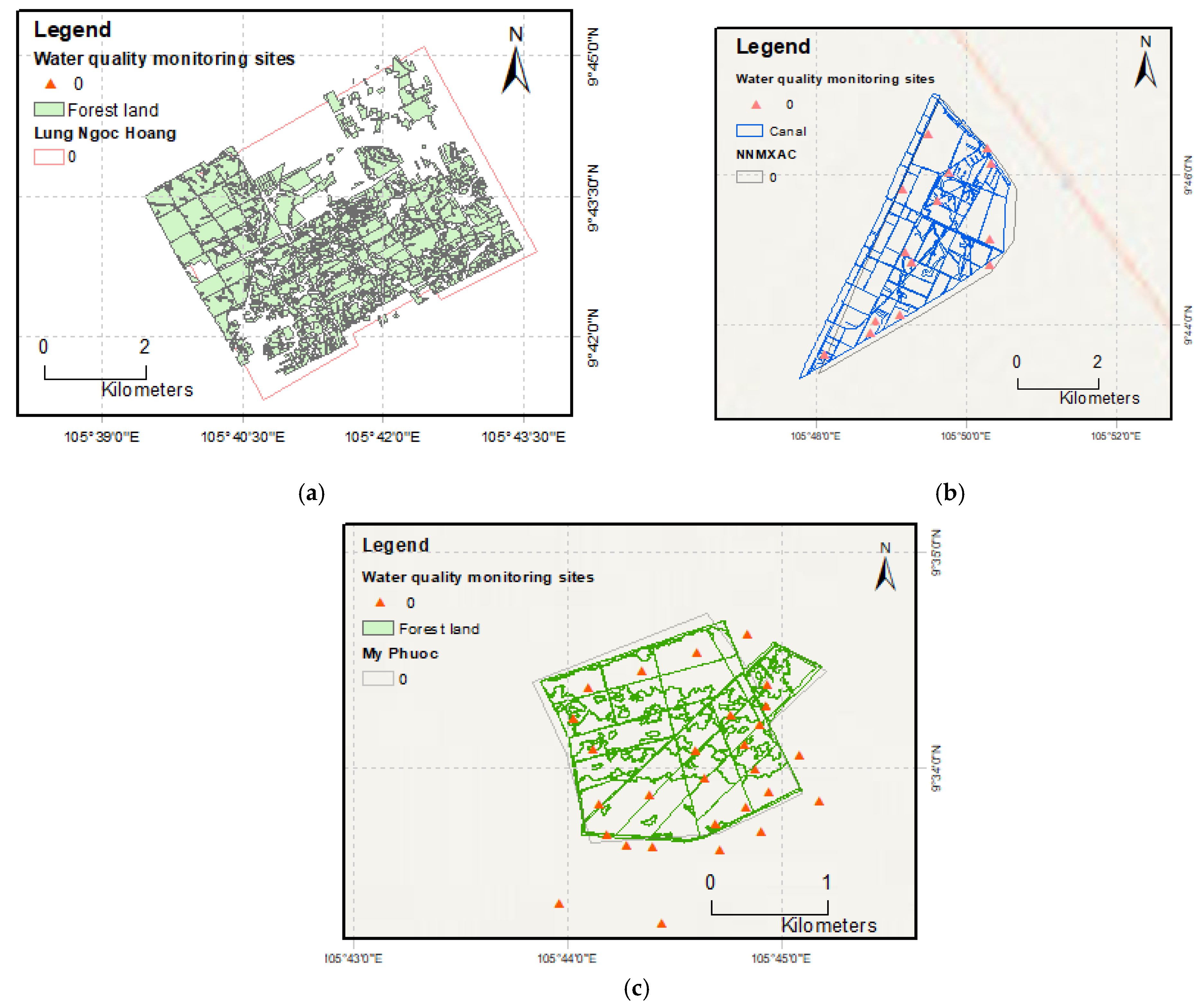
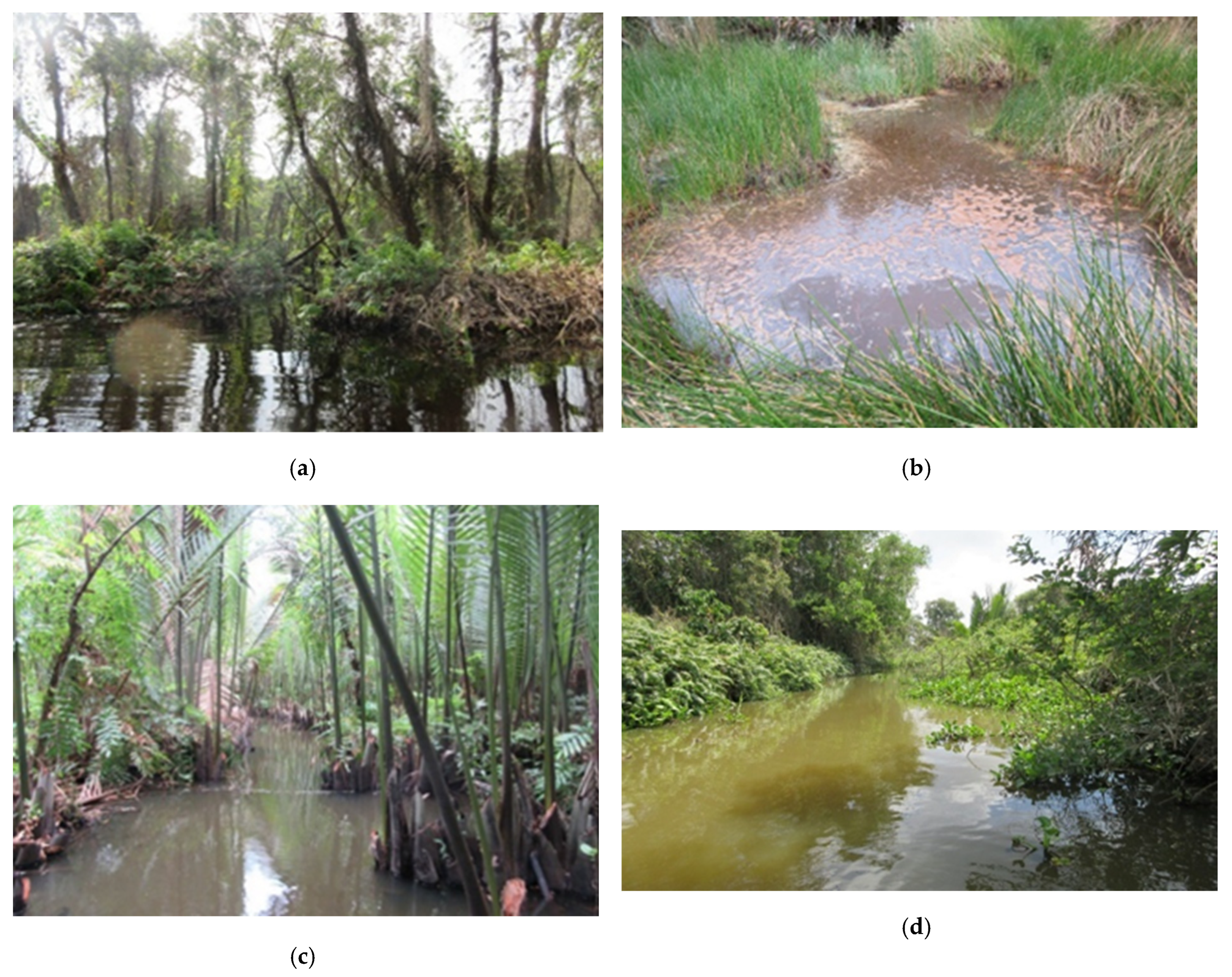
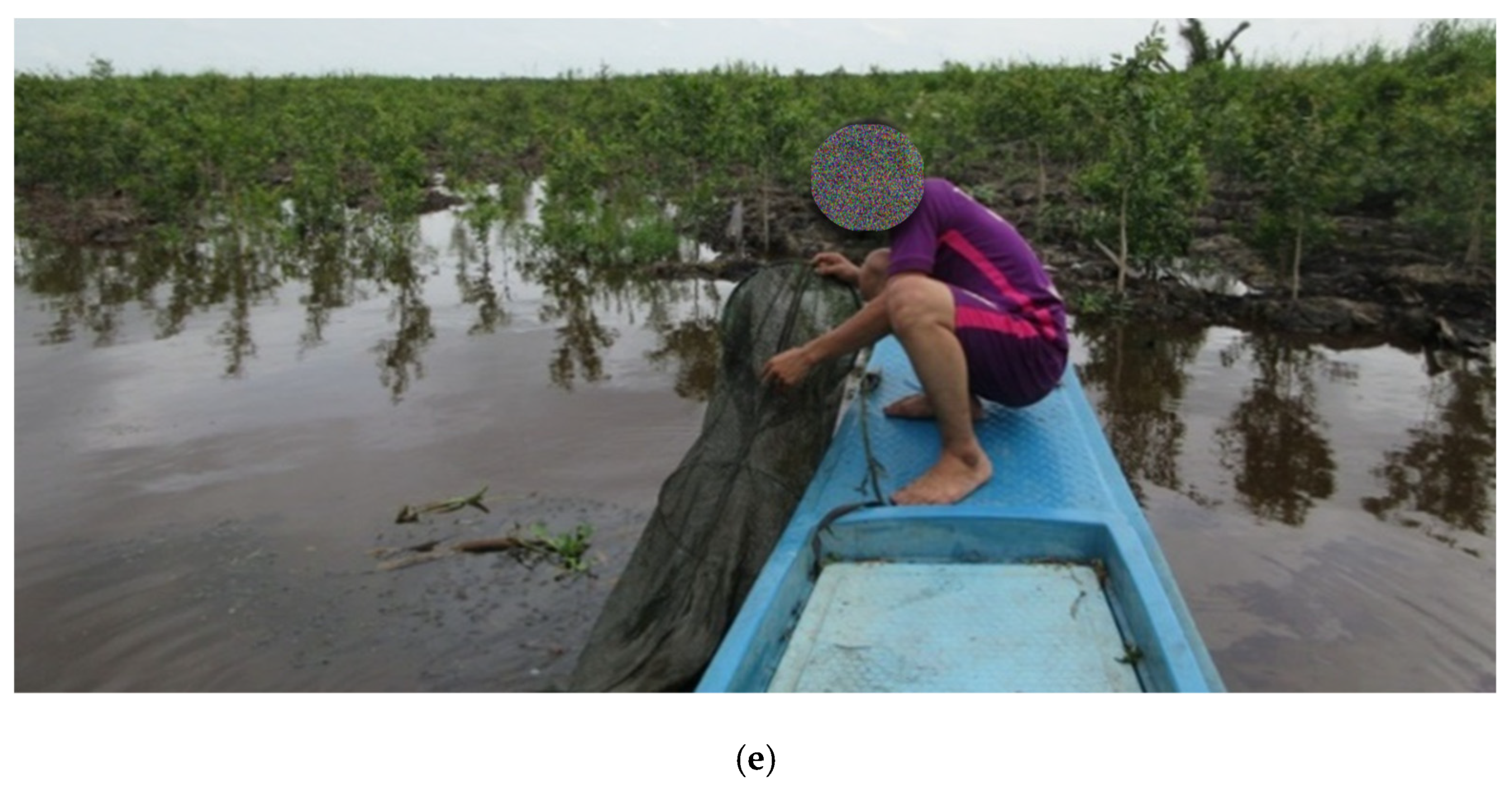
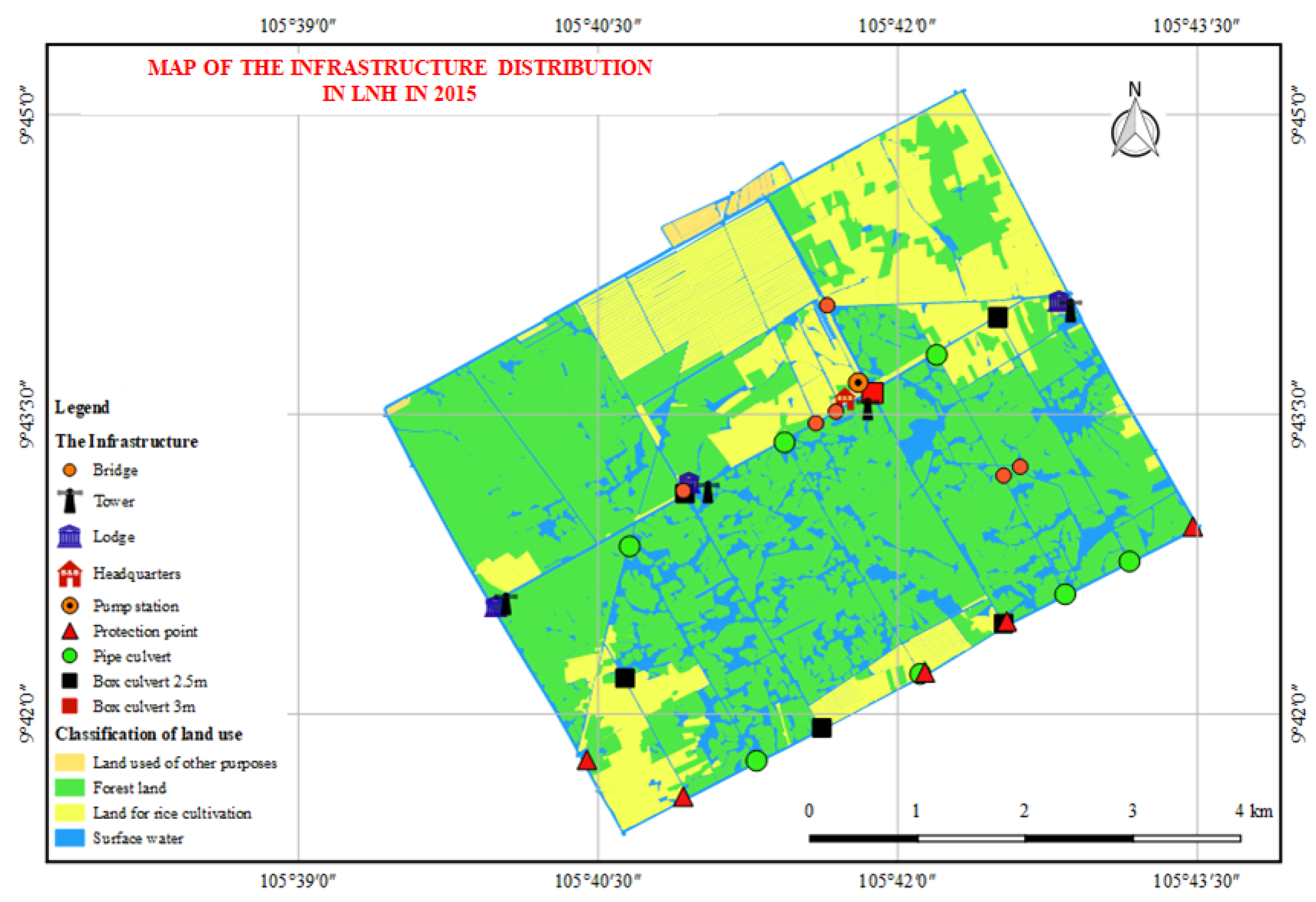
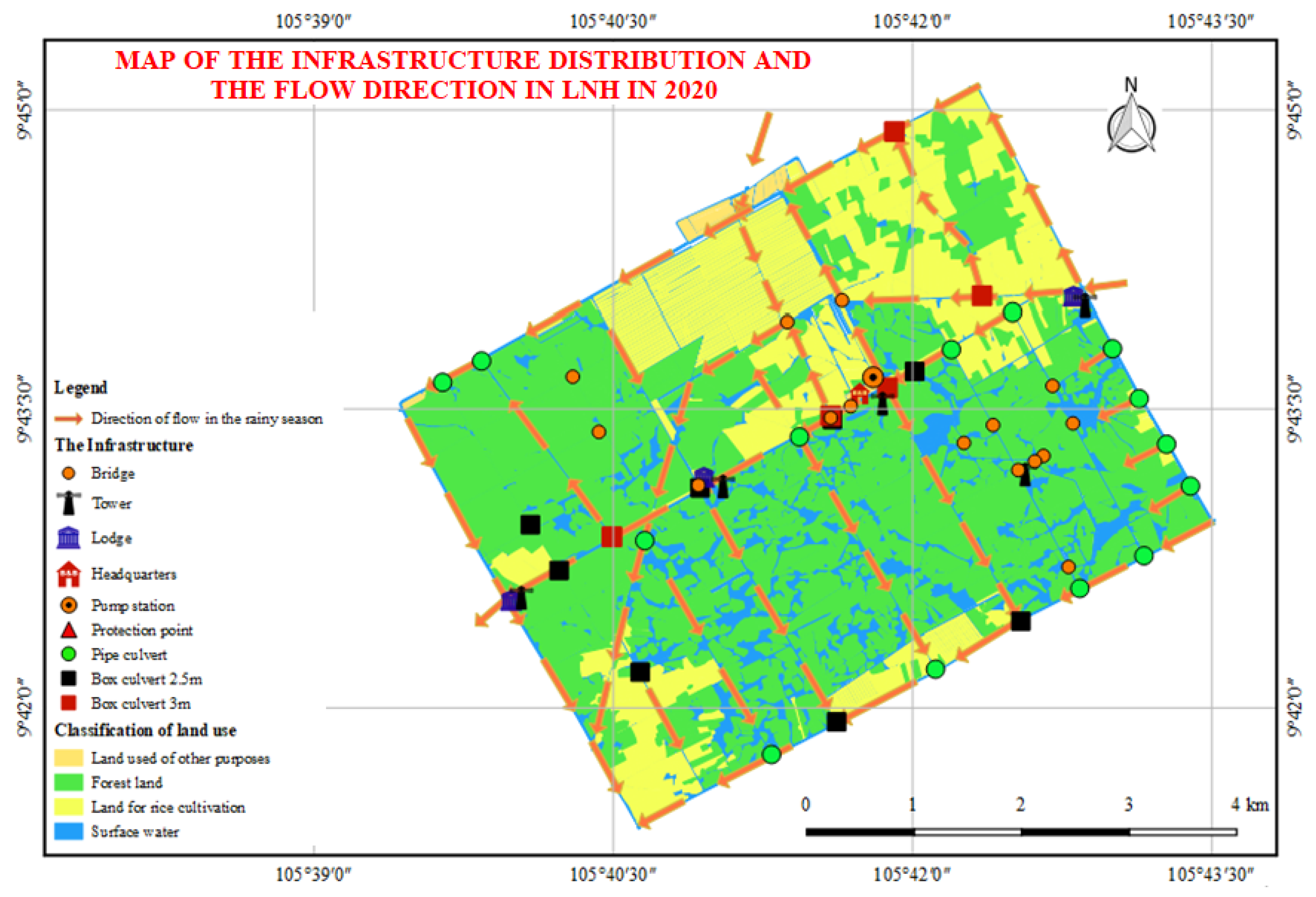
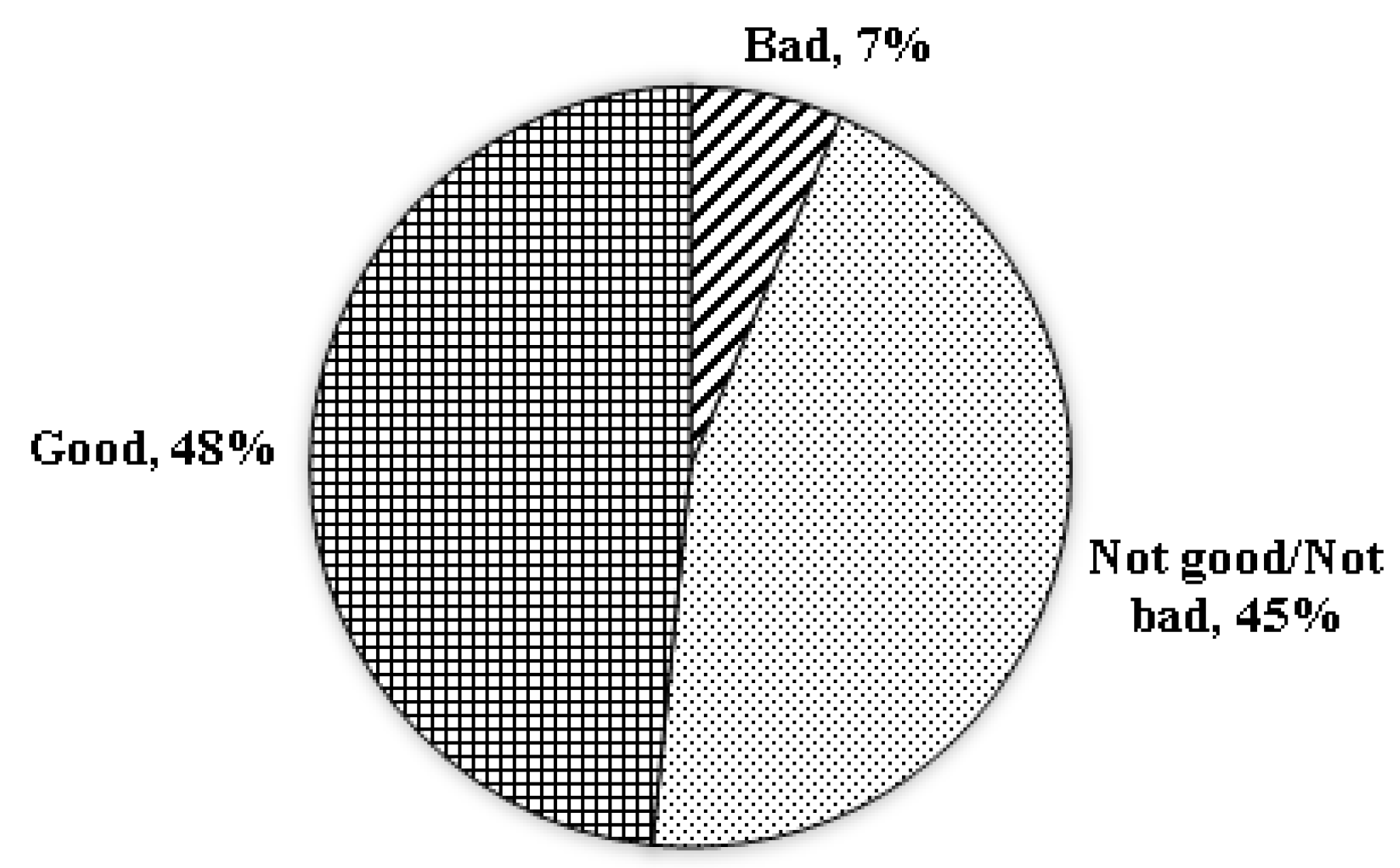
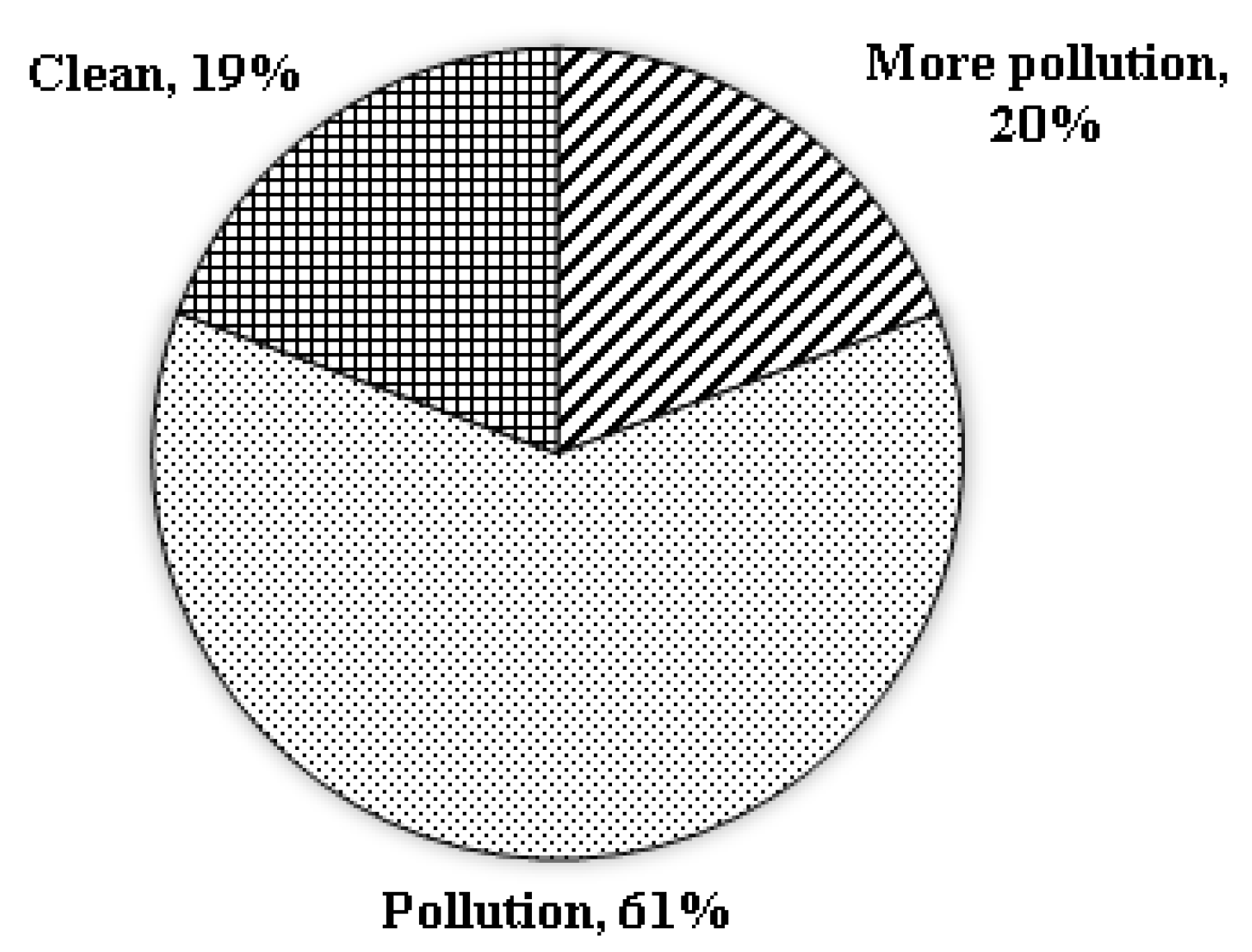

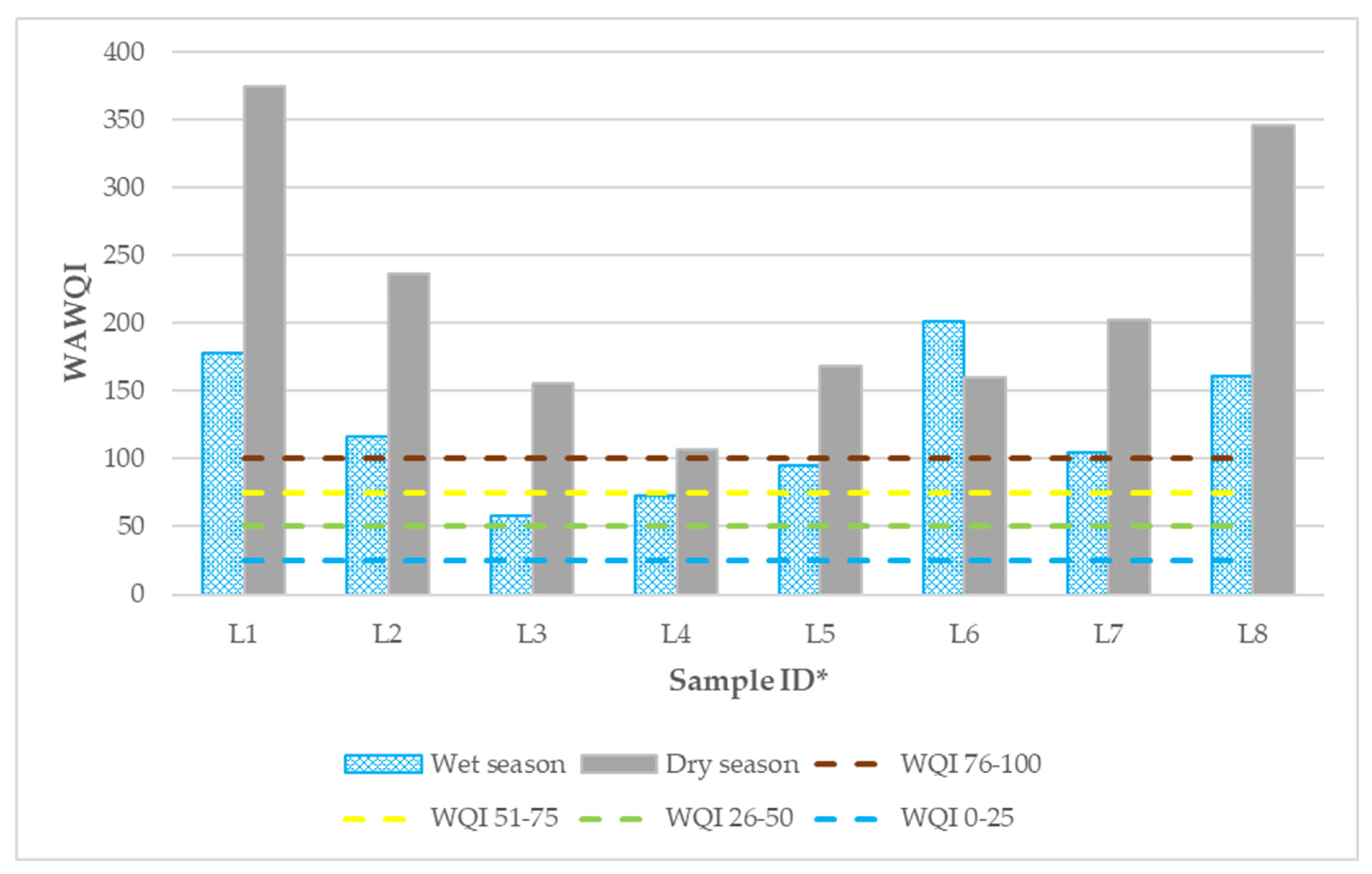
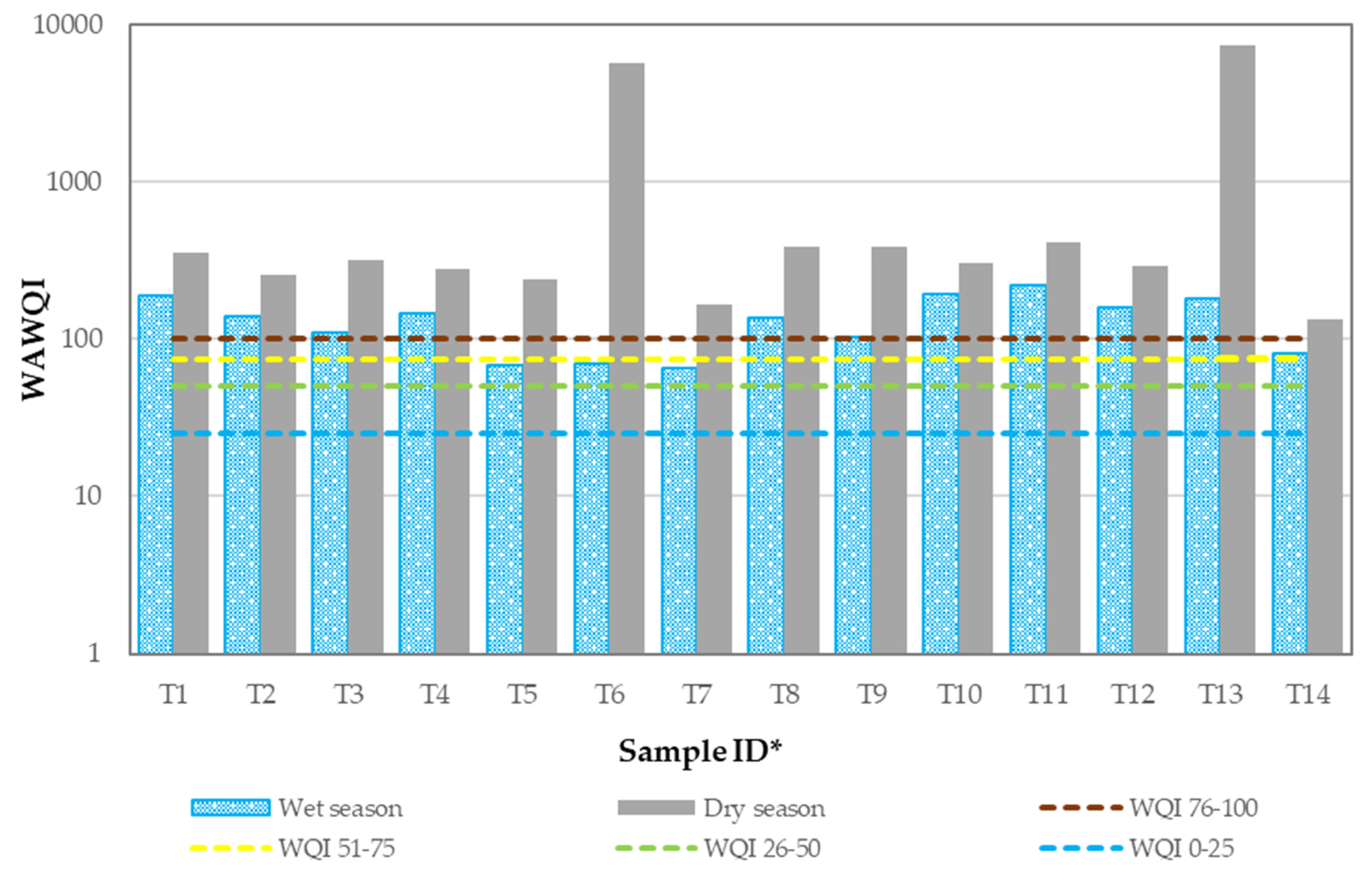
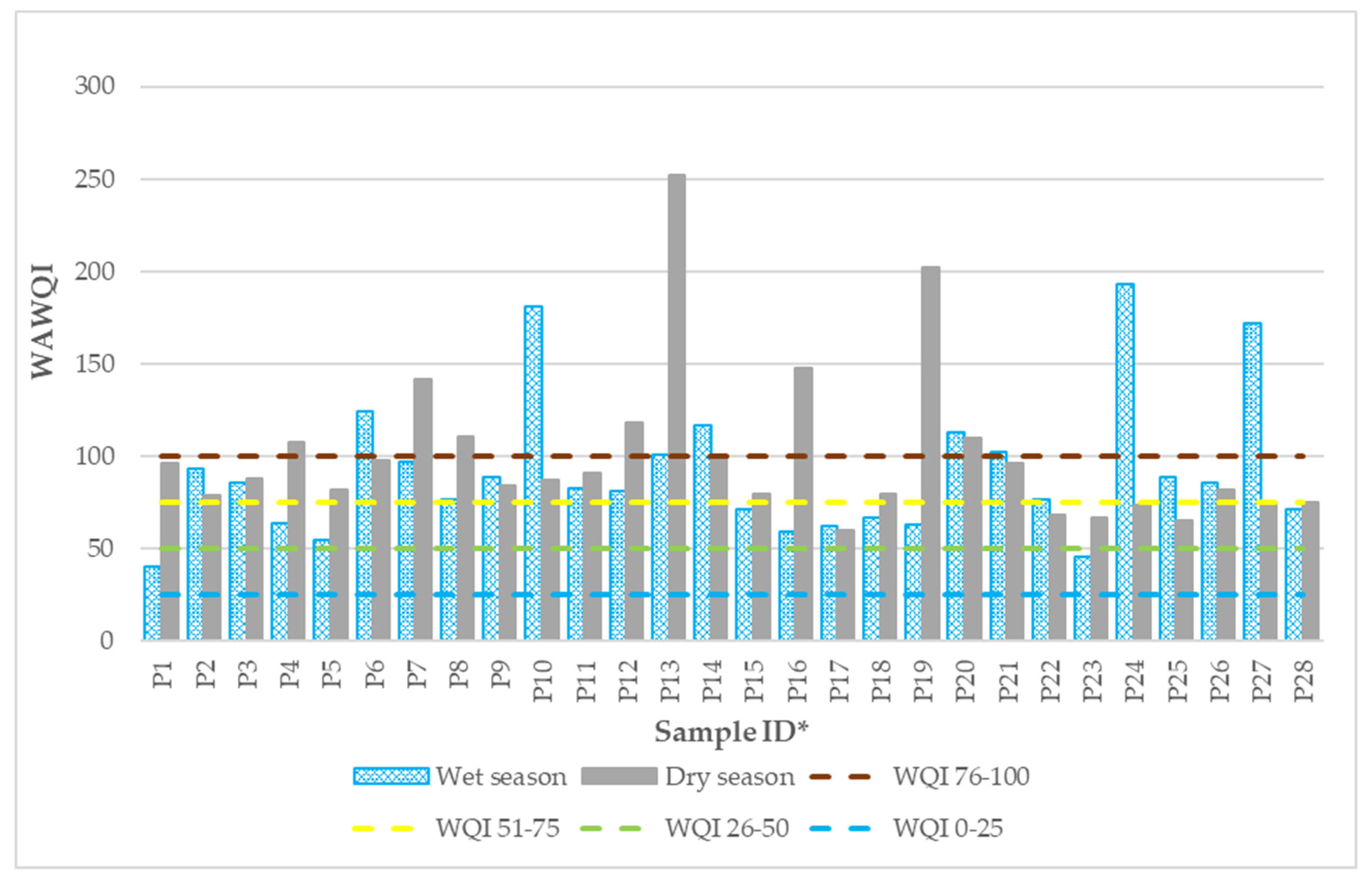
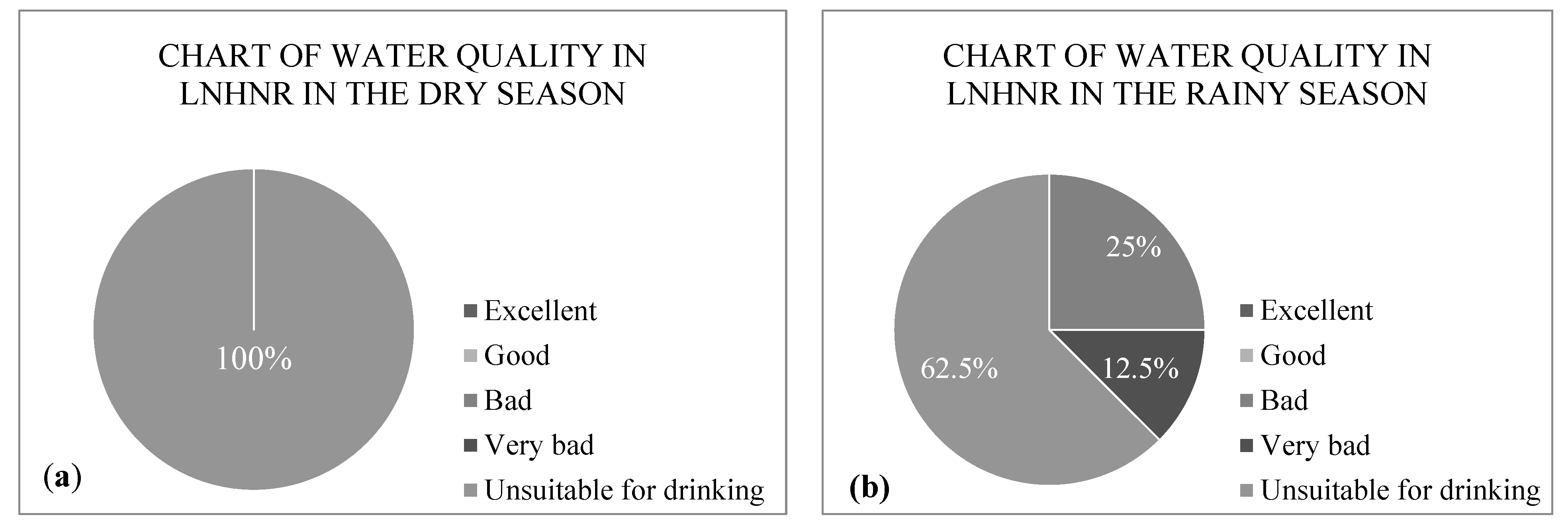
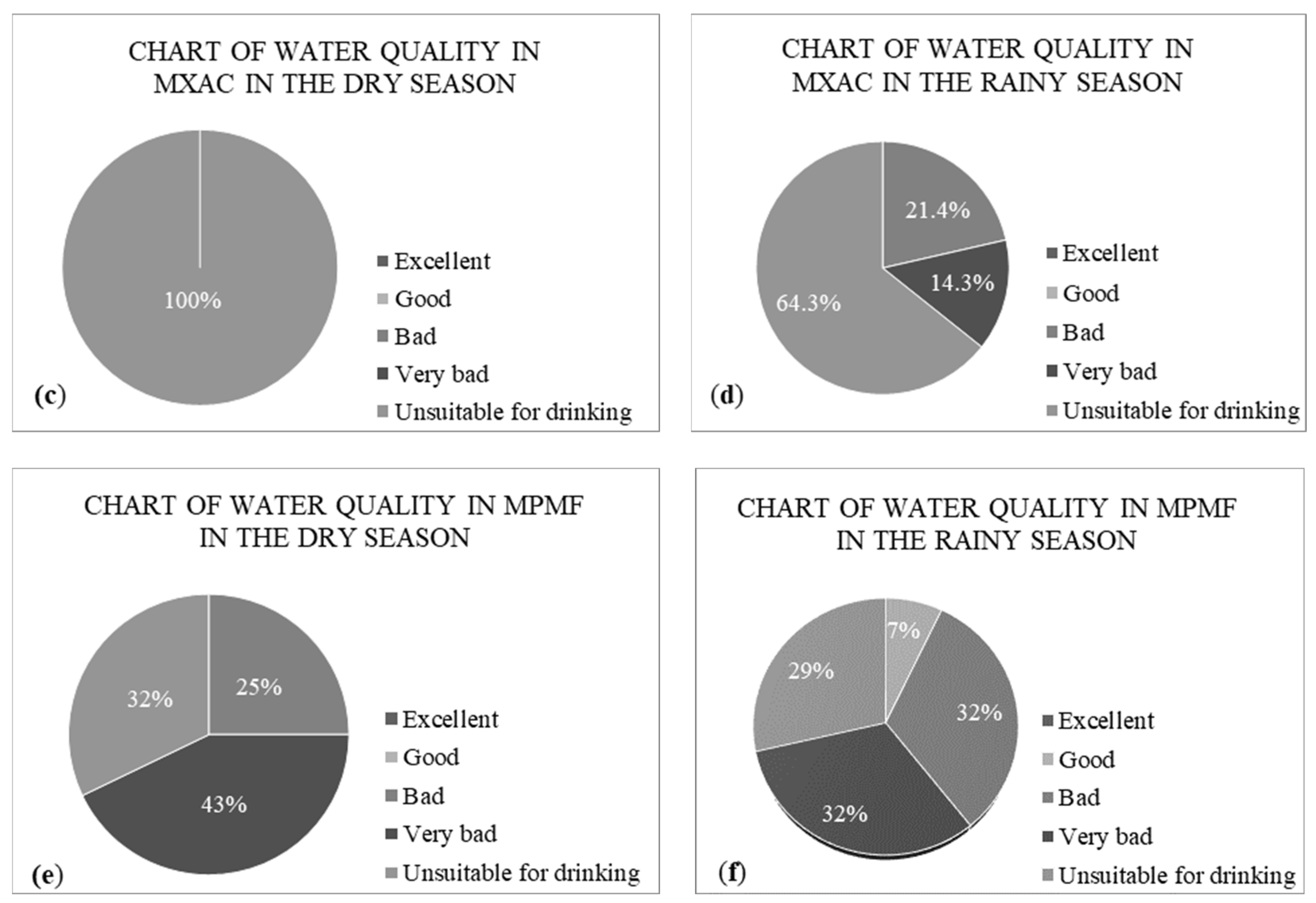
| Sample ID * | Sampling Site | Sample ID * | Sampling Site |
|---|---|---|---|
| Locational Features | Locational Features | ||
| L1 | Level 2 canal (TKII canal, plot 88) | P1 | Canal habitat |
| L2 | Sub-branch canal (plot 85) | P2 | Nypa fruticans habitat |
| L3 | Sub-branch canal (plot 27) | P3 | Canal habitat |
| L4 | Sub-branch canal (plot 5, plot 32) | P4 | Control canal in buffer zone |
| L5 | Level 2 canal (plot 1, plot 7) | P5 | Control canal in buffer zone surrounded by the trees and Acacia auriculiformis |
| L6 | Sub-branch canal (plot 45) | P6 | Canal habitat surrounded by tropical hornwort, Ipomoea aquatic, Eichhornia crassipes |
| L7 | Level 1 canal (Hau Giang 3 canal, plot 48) | P7 | Nypa fruticans habitat |
| L8 | Level 1 canal (Phung Hiep canal) | P8 | Canal habitat |
| T1 | Melaleuca habitat | P9 | Canal habitat |
| T2 | Melaleuca habitat | P10 | Wetland habitat |
| T3 | Melaleuca habitat | P11 | Melaleuca habitat |
| T4 | Melaleuca habitat | P12 | Melaleuca habitat |
| T5 | Melaleuca habitat | P13 | Melaleuca habitat with floating membrane surrounded by Melaleuca, Nypoideae |
| T6 | Melaleuca habitat | P14 | Melaleuca habitat surrounded by tropical hornwort, Annona glabra, Melaleuca, Nypoideae |
| T7 | Melaleuca habitat | P15 | Canal habitat with Eichhornia crassipes |
| T8 | Melaleuca habitat | P16 | Canal habitat with Eichhornia crassipes |
| T9 | Melaleuca habitat | P17 | Canal habitat |
| T10 | Paddy habitat | P18 | Canal habitat with Eichhornia crassipes |
| T11 | Paddy habitat | P19 | Canal habitat with membrane and Eichhornia crassipes |
| T12 | Sugarcane habitat | P20 | Nypa fruticans habitat |
| T13 | Sugarcane habitat | P21 | Nypa fruticans habitat |
| T14 | Sugarcane habitat | P22 | Canal habitat surrounded by Eichhornia crassipes, Stenochlaena palustris Annona glabra |
| - | - | P23 | Canal habitat, surrounded by Pistia stratiotes L, Stenochlaena palustris Annona glabra, Neptunia oleracea |
| - | - | P24 | Canal habitat with Eichhornia crassipes Annona glabra, |
| - | - | P25 | Canal habitat with Annona glabra, Stenochlaena palustris, Eichhornia crassipes |
| - | - | P26 | Level 1 canal |
| - | - | P27 | Nypa fruticans habitat with tropical hornwort, Eichhornia crassipes, Pistia stratiotes L, |
| - | - | P28 | Canal habitat with Eichhornia crassipes, tropical hornwort |
| Range of WAWQI | Classification of Water Quality |
|---|---|
| <25 | Excellent |
| 26–50 | Good |
| 51–75 | Poor |
| 76–100 | Very poor |
| >100 | Unsuitable for drinking |
| No | Parameters | Standard (Si) | Units |
|---|---|---|---|
| 1 | pH | 8.5 | |
| 2 | EC | 300 ** | µS/cm |
| 3 | COD | 10 | mg/L |
| 4 | PO43− | 0.1 | mg/L |
| 5 | BOD5 | 4 | mg/L |
| 6 | DO | 6 | mg/L |
| 7 | NO3− | 2 | mg/L |
| 8 | NH4+ | 0.3 | mg/L |
| 9 | TSS | 20 | mg/L |
| 10 | Fe | 0.5 | Mg/L |
| Sample ID * | EC | pH | COD | PO43− | BOD5 | DO | WAWQI |
|---|---|---|---|---|---|---|---|
| µS/cm | mg/L | ||||||
| QCVN 08-MT:2015/BTNMT (Column A1) | 300 ** | 6.5–8.5 | 10 | 0.1 | 4 | 6 | |
| L1 | 276 | 6.94 | 11.28 | 0.18 | 4.85 | 4.73 | 178 |
| L2 | 278 | 7.02 | 12.73 | 0.12 | 5.48 | 3.25 | 116 |
| L3 | 274 | 7.03 | 16.78 | 0.05 | 7.22 | 3.83 | 58 |
| L4 | 291 | 6.96 | 19.17 | 0.07 | 8.24 | 3.09 | 73 |
| L5 | 272 | 6.94 | 23.20 | 0.09 | 9.98 | 3.65 | 95 |
| L6 | 297 | 6.80 | 22.40 | 0.20 | 9.63 | 4.11 | 201 |
| L7 | 265 | 7.16 | 7.74 | 0.11 | 3.33 | 4.79 | 105 |
| Descriptive Statistics | |||||||
| Maximum | 297 | 7.16 | 23.20 | 0.20 | 9.98 | 4.79 | 201 |
| Minimum | 265 | 6.80 | 7.74 | 0.05 | 3.33 | 3.09 | 58 |
| Mean | 279 | 6.97 | 15.98 | 0.12 | 6.87 | 4.00 | 123 |
| SD | 10 | 0.09 | 5.08 | 0.05 | 2.19 | 0.61 | 48 |
| Sample ID * | EC | pH | COD | PO43− | BOD5 | DO | WAWQI |
|---|---|---|---|---|---|---|---|
| µS/cm | mg/L | ||||||
| QCVN 08-MT:2015/BTNMT (Column A1) | 300 ** | 6.5–8.5 | 10 | 0.1 | 4 | 6 | |
| L1 | 306.80 | 7.17 | 10.17 | 0.39 | 4.37 | 4.33 | 375 |
| L2 | 301.40 | 7.19 | 14.43 | 0.24 | 6.21 | 2.67 | 236 |
| L3 | 275.73 | 7.16 | 18.07 | 0.16 | 7.77 | 2.72 | 156 |
| L4 | 309.00 | 7.01 | 14.60 | 0.11 | 6.28 | 3.11 | 107 |
| L5 | 284.43 | 7.20 | 27.27 | 0.17 | 11.72 | 5.38 | 168 |
| L6 | 316.10 | 7.17 | 15.87 | 0.16 | 6.82 | 4.70 | 160 |
| L7 | 323.00 | 7.14 | 8.83 | 0.21 | 3.80 | 4.84 | 202 |
| Descriptive Statistics | |||||||
| Maximum | 323.00 | 7.20 | 27.27 | 0.39 | 11.72 | 5.38 | 375 |
| Minimum | 275.73 | 7.01 | 8.83 | 0.11 | 3.80 | 2.67 | 107 |
| Mean | 301.50 | 7.15 | 15.63 | 0.23 | 6.72 | 4.03 | 219 |
| SD | 14.79 | 0.06 | 5.24 | 0.10 | 2.25 | 0.98 | 89 |
| Sample ID * | EC | pH | COD | PO43− | NH4+ | Fe | BOD5 | DO | WAWQI |
|---|---|---|---|---|---|---|---|---|---|
| µS/cm | mg/L | ||||||||
| QCVN 08-T:2015/BTNMT (Column A1) | 300 ** | 6.5–8.5 | 10 | 0.1 | 0.3 | 0.5 | 4 | 6 | |
| T1 | 530 | 6.83 | 42.7 | 0.41 | 0.70 | 1.49 | 26.70 | 2.50 | 357 |
| T2 | 315 | 7.13 | 32.0 | 0.33 | 0.30 | 0.64 | 26.20 | 2.60 | 257 |
| T3 | 545 | 6.83 | 64.0 | 0.36 | 0.60 | 1.47 | 22.20 | 2.70 | 318 |
| T4 | 406 | 6.84 | 58.7 | 0.33 | 0.30 | 1.46 | 26.20 | 1.33 | 280 |
| T5 | 216 | 6.90 | 48.0 | 0.29 | 0.20 | 1.10 | 25.30 | 2.02 | 237 |
| T6 | 248 | 6.80 | 42.7 | 9.01 | 0.10 | 0.89 | 27.60 | 1.92 | 5686 |
| T7 | 272 | 6.84 | 42.7 | 0.17 | ND | 0.52 | 20.4 | 3.44 | 166 |
| T8 | 258 | 6.97 | 42.7 | 0.56 | 0.1 | 0.73 | 13.8 | 1.73 | 386 |
| T9 | 454 | 6.61 | 170.7 | 0.25 | ND | 3.27 | 148 | 1.5 | 390 |
| T10 | 282 | 6.81 | 58.7 | 0.4 | 0.2 | 1 | 29.8 | 1.3 | 306 |
| T11 | 423 | 6.91 | 58.7 | 0.45 | ND | 1.09 | 22.2 | 1.3 | 408 |
| T12 | 488 | 6.94 | 64 | 0.31 | ND | 0.71 | 28.9 | 1.6 | 289 |
| T13 | 253 | 6.92 | 42.7 | 9.2 | ND | 1.47 | 25.3 | 2 | 7344 |
| T14 | 242 | 7.34 | 64 | 0.14 | 0.2 | 0.83 | 17.8 | 7.5 | 134 |
| Descriptive Statistics | |||||||||
| Maximum | 545 | 7.34 | 170.7 | 9.2 | 0.7 | 3.27 | 148 | 7.5 | 7344 |
| Minimum | 216 | 6.61 | 32 | 0.14 | 0.10 | 0.52 | 13.8 | 1.3 | 134 |
| Mean | 352.29 | 6.91 | 59.45 | 1.59 | 0.30 | 1.19 | 32.89 | 2.39 | 1183 |
| SD | 112.92 | 0.16 | 32.43 | 3.07 | 0.20 | 0.66 | 32.21 | 1.54 | 2201 |
| Sample ID * | EC | pH | COD | PO43− | NH4+ | Fe | BOD5 | DO | WAWQI |
|---|---|---|---|---|---|---|---|---|---|
| µS/cm | mg/L | ||||||||
| QCVN 08-T:2015/BTNMT (Column A1) | 300 ** | 6.5–8.5 | 10 | 0.1 | 0.3 | 0.5 | 4 | 6 | |
| T1 | 195 | 6.26 | 5.2 | 0.25 | 0.00 | 1.12 | 4.00 | 3.10 | 187 |
| T2 | 191 | 6.24 | 3.8 | 0.17 | 0.00 | 1.24 | 1.90 | 3.30 | 140 |
| T3 | 203 | 6.22 | 4.1 | 0.15 | 0.00 | 0.55 | 2.40 | 3.50 | 110 |
| T4 | 223 | 6.26 | 3.7 | 0.19 | 0.00 | 1.00 | 1.60 | 1.90 | 146 |
| T5 | 579 | 5.71 | 5.5 | 0.04 | 0.00 | 1.60 | 5.20 | 2.70 | 68 |
| T6 | 380 | 6.15 | 6.8 | 0.07 | 0.00 | 0.87 | 5.90 | 2.30 | 70 |
| T7 | 560 | 5.91 | 7 | 0.03 | ND | 1.14 | 5.6 | 1.6 | 65 |
| T8 | 278 | 6.35 | 7.4 | 0.13 | ND | 0.87 | 5 | 2.7 | 135 |
| T9 | 553 | 5.65 | 7.8 | 0.04 | ND | 2.11 | 5 | 1.6 | 103 |
| T10 | 292 | 6.11 | 4.7 | 0.18 | ND | 1.49 | 2.5 | 2 | 193 |
| T11 | 243 | 6.31 | 4 | 0.22 | ND | 1.4 | 2.2 | 1.6 | 221 |
| T12 | 584 | 6.44 | 17 | 0.17 | ND | 0.6 | 6.5 | 2.1 | 160 |
| T13 | 212 | 6.15 | 4.2 | 0.18 | ND | 1.07 | 2.4 | 2.9 | 179 |
| T14 | 432 | 6.3 | 5.1 | 0.09 | ND | 0.19 | 4.9 | 5.5 | 81 |
| Descriptive Statistics | |||||||||
| Maximum | 584 | 6.44 | 17 | 0.25 | 0 | 2.11 | 6.5 | 5.5 | 221 |
| Minimum | 191 | 5.65 | 3.7 | 0.03 | 0 | 0.19 | 1.6 | 1.6 | 65 |
| Mean | 351.79 | 6.15 | 6.16 | 0.14 | 0 | 1.09 | 3.94 | 2.63 | 133 |
| SD | 152.64 | 0.23 | 3.29 | 0.07 | 0 | 0.46 | 1.63 | 1.01 | 49 |
| Sample ID * | EC | pH | COD | PO43− | NH4+ | NO3− | TSS | BOD5 | DO | WAWQI |
|---|---|---|---|---|---|---|---|---|---|---|
| µS/cm | mg/L | |||||||||
| QCVN 08-T:2015/BTNMT (Column A1) | 300 ** | 6.5–8.5 | 10 | 0.1 | 0.3 | 0.5 | 20 | 4 | 6 | |
| P1 | 1950 | 6.8 | 18 | 0.1 | 0.2 | 3.145 | 8.40 | 2.48 | 4.2 | 96 |
| P2 | 460 | 6.8 | 18.5 | 0.09 | 0.1 | 2.168 | 7.90 | 2.32 | 4.28 | 79 |
| P3 | 1990 | 6.5 | 16.5 | 0.08 | 0.3 | 2.517 | 6.40 | 1.49 | 4.19 | 88 |
| P4 | 2100 | 6.6 | 18 | 0.13 | 0.1 | 2.13 | 11.40 | 2.69 | 5.1 | 108 |
| P5 | 2150 | 6.3 | 19.5 | 0.1 | 0.1 | 1.21 | 3.50 | 0.67 | 5.44 | 82 |
| P6 | 318 | 6.01 | 90 | 0.09 | 0.25 | 2.38 | 12.40 | 3.48 | 2.34 | 98 |
| P7 | 341 | 6.33 | 110 | 0.15 | 0.2 | 3.808 | 18.80 | 4.40 | 3.02 | 142 |
| P8 | 322 | 6.9 | 95 | 0.1 | 0.3 | 3.618 | 10.20 | 2.08 | 2.47 | 111 |
| P9 | 330 | 4.57 | 111 | 0.08 | 0.1 | 3.5 | 17.60 | 4.24 | 3.22 | 84 |
| P10 | 338 | 6.51 | 100 | 0.09 | 0.09 | 2.987 | 11.20 | 2.51 | 1.74 | 87 |
| P11 | 329 | 5.21 | 116 | 0.09 | 0.15 | 3.018 | 8.90 | 1.87 | 2.9 | 91 |
| P12 | 330 | 6.35 | 90 | 0.085 | 0.5 | 3.331 | 18.50 | 4.53 | 2.12 | 118 |
| P13 | 334 | 6.53 | 90 | 0.3 | 0.3 | 3.025 | 22.30 | 5.44 | 1.52 | 252 |
| P14 | 333 | 6.12 | 110 | 0.1 | 0.1 | 3.103 | 24.10 | 5.52 | 1.18 | 101 |
| P15 | 322 | 6.83 | 18.5 | 0.05 | 0.45 | 3.003 | 8.20 | 1.71 | 3.48 | 80 |
| P16 | 316 | 7.01 | 19 | 0.15 | 0.4 | 2.725 | 14.60 | 3.44 | 4.24 | 148 |
| P17 | 331 | 6.85 | 18.5 | 0.06 | 0.1 | 2.015 | 12.30 | 2.53 | 4.23 | 60 |
| P18 | 334 | 6.89 | 20.5 | 0.085 | 0.15 | 2.12 | 8.70 | 2.12 | 5.43 | 80 |
| P19 | 379 | 6.78 | 19.5 | 0.25 | 0.22 | 3.04 | 12.40 | 2.88 | 4.85 | 202 |
| P20 | 350 | 6.5 | 19.5 | 0.09 | 0.38 | 3.415 | 24.60 | 8.64 | 4.56 | 110 |
| P21 | 347 | 6.68 | 18.5 | 0.1 | 0.1 | 3.221 | 26.20 | 8.64 | 4.37 | 96 |
| P22 | 336 | 6.01 | 105.2 | 0.026 | 0.47 | 2.015 | 6.0 | 4.24 | 2.65 | 68 |
| P23 | 332 | 6.41 | 108.9 | 0.026 | 0.45 | 2.201 | 5.0 | 3.44 | 1.62 | 67 |
| P24 | 335 | 6.51 | 113.6 | 0.026 | 0.51 | 2.613 | 8.0 | 4.24 | 1.67 | 74 |
| P25 | 334 | 6.6 | 113.6 | 0.021 | 0.40 | 2.915 | 12.5 | 2.53 | 1.82 | 65 |
| P26 | 335 | 6.65 | 120.3 | 0.036 | 0.46 | 3.025 | 17.5 | 2.12 | 1.97 | 82 |
| P27 | 338 | 6.9 | 119.3 | 0.021 | 0.53 | 3.08 | 10.5 | 2.08 | 3.9 | 75 |
| P28 | 326 | 7.06 | 111.0 | 0.060 | 0.24 | 3.209 | 0.5 | 2.32 | 1.83 | 75 |
| Descriptive Statistics | ||||||||||
| Maximum | 2150 | 7 | 120 | 0.3 | 0.53 | 3.81 | 26.2 | 8.64 | 5.44 | 252 |
| Minimum | 316 | 4.57 | 16.5 | 0.02 | 0.09 | 1.21 | 0.5 | 0.67 | 1.18 | 60 |
| Mean | 583.57 | 6.47 | 68.87 | 0.09 | 0.27 | 2.80 | 12.45 | 3.38 | 3.23 | 101 |
| SD | 598.98 | 0.52 | 44.1 | 0.06 | 0.15 | 0.58 | 6.47 | 1.86 | 1.30 | 41 |
| Sample ID * | EC | pH | COD | PO43− | NH4+ | NO3− | TSS | BOD5 | DO | WAWQI |
|---|---|---|---|---|---|---|---|---|---|---|
| µS/cm | mg/L | |||||||||
| QCVN 08-T:2015/BTNMT (Column A1) | 300 ** | 6.5–8.5 | 10 | 0.1 | 0.3 | 0.5 | 4 | 6 | ||
| P1 | 1640 | 6.94 | 75 | 0.010 | 0.189 | 2.985 | 14 | 5.91 | 1.75 | 40 |
| P2 | 1467 | 5.38 | 90 | 0.015 | 0.671 | 2.776 | 44 | 3.55 | 0.79 | 93 |
| P3 | 1275 | 5.87 | 90 | 0.040 | 0.450 | 2.615 | 27 | 2.85 | 0.67 | 86 |
| P4 | 1611 | 5.76 | 80 | 0.020 | 0.328 | 1.942 | 36 | 3.01 | 3.36 | 64 |
| P5 | 1382 | 6.18 | 82 | 0.025 | 0.247 | 2.005 | 19 | 3.31 | 0.54 | 55 |
| P6 | 1195 | 6.67 | 77 | 0.045 | 0.484 | 2.635 | 102 | 3.97 | 0.79 | 124 |
| P7 | 619 | 6.54 | 105 | 0.080 | 0.284 | 4.492 | 7 | 4.05 | 0.32 | 97 |
| P8 | 756 | 6.79 | 80 | 0.075 | 0.069 | 4.443 | 11 | 3.73 | 0.68 | 77 |
| P9 | 615 | 7.28 | 95 | 0.085 | 0.162 | 4.411 | 5 | 3.95 | 2.01 | 89 |
| P10 | 884 | 6.56 | 90 | 0.165 | 0.113 | 4.395 | 99 | 5.23 | 1.73 | 181 |
| P11 | 747 | 6.75 | 115 | 0.080 | 0.069 | 4.234 | 12 | 4.27 | 0.65 | 83 |
| P12 | 706 | 6.59 | 105 | 0.065 | 0.216 | 4.217 | 7 | 6.29 | 0.45 | 81 |
| P13 | 755 | 6.56 | 85 | 0.105 | 0.112 | 4.201 | 12 | 6.29 | 0.56 | 101 |
| P14 | 638 | 6.54 | 87 | 0.125 | 0.139 | 4.573 | 10 | 4.40 | 0.73 | 117 |
| P15 | 1514 | 6.94 | 77 | 0.055 | 0.199 | 4.406 | 6 | 5.65 | 1.76 | 71 |
| P16 | 1471 | 6.85 | 80 | 0.040 | 0.186 | 4.125 | 6 | 7.09 | 1.54 | 59 |
| P17 | 1308 | 6.23 | 90 | 0.030 | 0.168 | 4.337 | 30 | 3.73 | 1.49 | 62 |
| P18 | 1179 | 5.33 | 80 | 0.020 | 0.215 | 3.987 | 55 | 4.96 | 1.87 | 67 |
| P19 | 1357 | 6 | 80 | 0.040 | 0.129 | 4.014 | 27 | 3.36 | 1.31 | 63 |
| P20 | 1478 | 5.77 | 90 | 0.045 | 0.324 | 4.403 | 97 | 5.81 | 2.73 | 113 |
| P21 | 717 | 6.54 | 110 | 0.105 | 0.096 | 4.783 | 11 | 2.83 | 1.27 | 102 |
| P22 | 1221 | 6.45 | 95 | 0.060 | 0.200 | 2.748 | 18 | 2.40 | 0.7 | 77 |
| P23 | 1378 | 6.14 | 85 | 0.030 | 0.012 | 2.416 | 30 | 3.55 | 0.94 | 46 |
| P24 | 1414 | 6.02 | 85 | 0.030 | 1.883 | 3.675 | 34 | 3.68 | 0.58 | 193 |
| P25 | 1406 | 6.01 | 90 | 0.035 | 0.474 | 3.669 | 33 | 3.87 | 0.4 | 89 |
| P26 | 1439 | 5.94 | 90 | 0.030 | 0.457 | 4.107 | 37 | 4.59 | 0.5 | 86 |
| P27 | 1432 | 5.64 | 70 | 0.035 | 1.514 | 4.321 | 42 | 6.48 | 0.71 | 172 |
| P28 | 1386 | 6.63 | 85 | 0.055 | 0.15 | 4.272 | 16 | 5.65 | 1.67 | 71 |
| Descriptive Statistics | ||||||||||
| Maximum | 1640 | 7.28 | 115 | 0.17 | 1.88 | 4.78 | 102 | 7.09 | 3.36 | 193 |
| Minimum | 615 | 5.33 | 70 | 0.01 | 0.012 | 1.94 | 5 | 2.4 | 0.32 | 40 |
| Mean | 1178.21 | 6.32 | 87.96 | 0.06 | 0.34 | 3.76 | 30.25 | 4.45 | 1.16 | 91 |
| SD | 337.24 | 0.48 | 10.43 | 0.04 | 0.41 | 0.84 | 27.29 | 1.25 | 0.73 | 37 |
Publisher’s Note: MDPI stays neutral with regard to jurisdictional claims in published maps and institutional affiliations. |
© 2022 by the authors. Licensee MDPI, Basel, Switzerland. This article is an open access article distributed under the terms and conditions of the Creative Commons Attribution (CC BY) license (https://creativecommons.org/licenses/by/4.0/).
Share and Cite
Lien, B.T.B.; Ngan, N.T.T.; Kumar, P.; Dang, T.T.T.; Hong, T.T.K.; Ty, T.V.; Avtar, R.; Minh, H.V.T. Assessing the Impacts of Dike Systems on Water Quality in Natural Reserves of the Vietnamese Mekong Delta. Urban Sci. 2022, 6, 21. https://doi.org/10.3390/urbansci6010021
Lien BTB, Ngan NTT, Kumar P, Dang TTT, Hong TTK, Ty TV, Avtar R, Minh HVT. Assessing the Impacts of Dike Systems on Water Quality in Natural Reserves of the Vietnamese Mekong Delta. Urban Science. 2022; 6(1):21. https://doi.org/10.3390/urbansci6010021
Chicago/Turabian StyleLien, Bui Thi Bich, Nguyen Thi Thanh Ngan, Pankaj Kumar, Trinh Trung Tri Dang, Tran Thi Kim Hong, Tran Van Ty, Ram Avtar, and Huynh Vuong Thu Minh. 2022. "Assessing the Impacts of Dike Systems on Water Quality in Natural Reserves of the Vietnamese Mekong Delta" Urban Science 6, no. 1: 21. https://doi.org/10.3390/urbansci6010021
APA StyleLien, B. T. B., Ngan, N. T. T., Kumar, P., Dang, T. T. T., Hong, T. T. K., Ty, T. V., Avtar, R., & Minh, H. V. T. (2022). Assessing the Impacts of Dike Systems on Water Quality in Natural Reserves of the Vietnamese Mekong Delta. Urban Science, 6(1), 21. https://doi.org/10.3390/urbansci6010021










